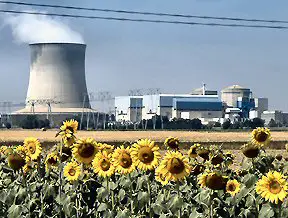Nuclear power is undergoing a period of rapid change. Several generations of reactors are commonly referred to.
Generation I reactors were developed in 1950-60s and relatively few are still running today. Most Gen I reactors used natural uranium fuel and with graphite as a moderator.
Generation II reactors are typified by the present United States fleet and most other reactors in operation elsewhere. These typically use enriched uranium fuel and are mostly cooled and moderated by water.
Generation III are the Advanced Reactors, the first three of which are in operation in Japan and others are under construction or ready to be ordered. They are developments of the second generation with enhanced safety. The most common reactors at present are:
Pressurized Water Reactors (PWR)
Boiling Water Reactors (BWR)
Pressurized Heavy Water Reactors (PHWR)
High Temperature Gas-cooled Reactors (HTGR)
Generation IV reactors (Gen IV) are a set of theoretical nuclear reactor designs currently being researched. These designs are generally not expected to be available for commercial construction prior to 2030. Current reactors in operation around the world are generally considered second- or third-generation systems, with the first-generation systems having been retired some time ago.
Research into these reactor types was officially started by the Generation IV International Forum (GIF) based on eight technology goals. The primary goals being to improve nuclear safety, improve proliferation resistance, minimize waste and natural resource utilization, and to decrease the cost to build and run such plants. Generation IV systems are intended to be responsive to the needs of a broad range of nations and users.
Nuclear Plants
A nuclear reactor is only a small part of the life-cycle for nuclear power. The process starts with mining. Generally, uranium mines are either open-pit strip mines, or in-situ leach mines. In either case, the uranium ore is extracted, usually converted into a stable and compact form such as yellow cake, and then transported to a processing facility.
At the reprocessing facility, the yellow cake is converted to uranium hexafluoride, which is then enriched using various techniques. At this point, the enriched uranium, containing more than the natural 0.7% U-235, is used to make rods of the proper composition and geometry for the particular reactor that the fuel is destined for. The fuel rods will spend about 3 years inside the reactor, generally until about 3% of their uranium has been fissioned, then they will be moved to a spent fuel pool where the short lived isotopes generated by fission can decay away.
After about 5 years in a cooling pond, the spent fuel is radioactively cool enough to handle, and it can be moved to dry storage areas or reprocessed.

Today there are about 440 nuclear power reactors across 31 countries, with a combined capacity of 370 GWe (Giga Watt electricity). In 2005 these power station generated 2,626 billion kWh, or over 16% of the world’s electricity.
The relative costs of generating electricity from nuclear plants, coal and gas vary considerably depending on location. Coal is, and will probably remain, economically attractive in countries such as China, the USA and Australia with abundant and accessible domestic coal resources as long as carbon emissions are cost-free. Gas is also competitive for base-load power in many places, particularly using combined-cycle plants, though rising gas prices have removed much of the advantage.
About 30 power reactors are currently being constructed in 11 countries, notably China, South Korea, Japan and Russia. Construction is well-advanced on many of them.
Most reactors currently planned are in the Asian region, with fast-growing economies and rapidly-rising electricity demand.
At least ten countries with existing nuke programs (Bulgaria, Canada, France Russia, China, India, Pakistan, Japan, South Korea and South Africa) have plans to build new power reactors (beyond those now under construction).
Storage Costs
A study released in early 2007 by the state of Nevada contradicts cost estimates from the U.S. Department of Energy and suggests the proposed Yucca Mountain nuclear waste repository would actually cost billions more than storing the waste at existing nuclear power reactor sites.
The analysis shows that it would cost $13.3 billion today to pay for the costs of dry storage at all 100 U.S. nuclear power reactor sites – “for all perpetuity.” Conversely, based on the same conditions, it would cost $38.3 billion to build the Yucca repository by DOE’s target date of 2025. The additional cost to store spent fuel until the repository is completed in 2025 is estimated at $5.8 billion.

